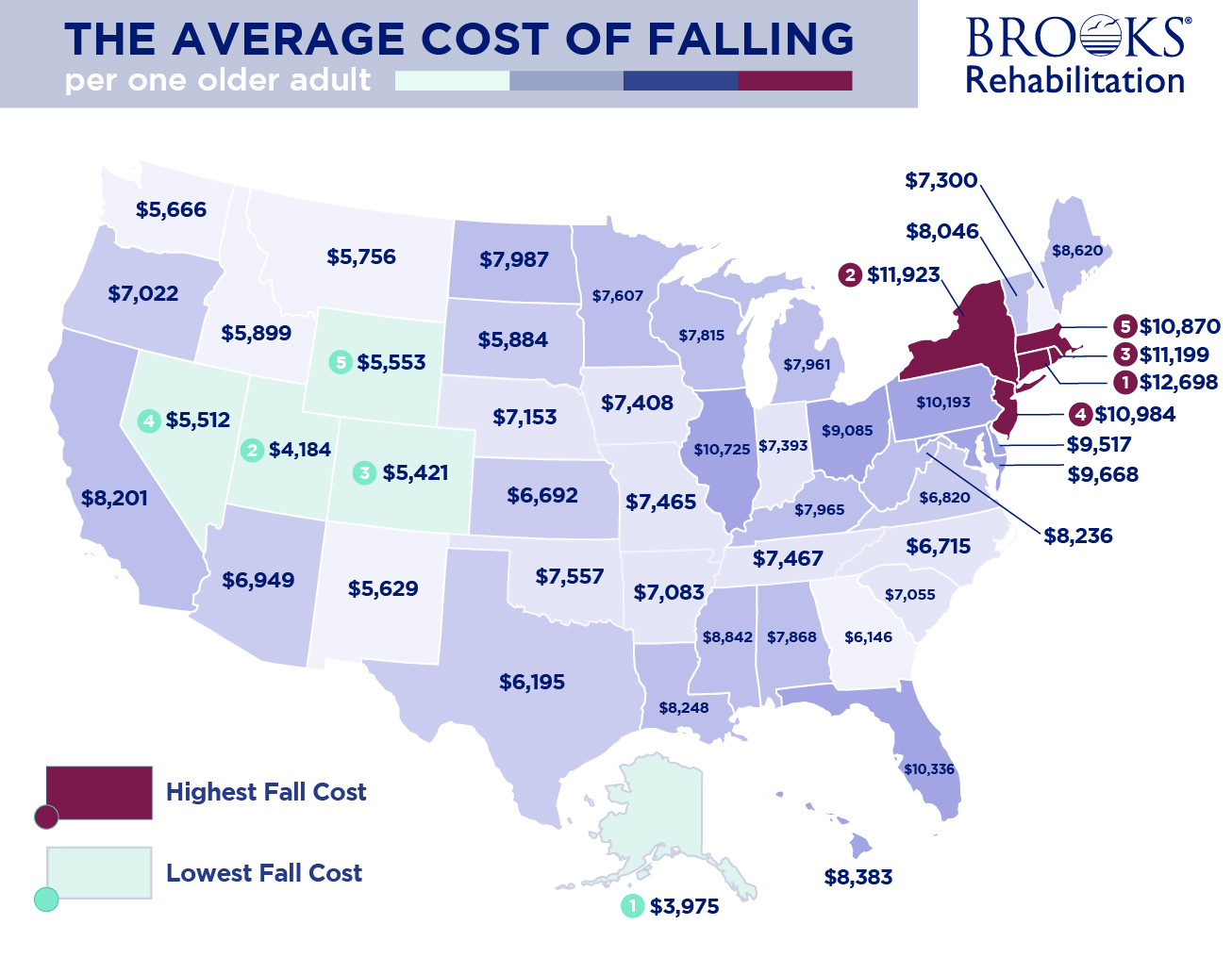The Cost of Falling

Back to physical health resource hub
Unintentional falls are the leading cause of emergency department visits in the U.S. across every age group, from infants to elders, according to the Centers for Disease Control and Prevention (CDC). While tripping, falling or being clumsy aren’t things people typically associate with serious health implications, one in five falls result in serious injuries, such as broken bones or head injuries. These can range from mild traumatic brain injuries, also known as concussions, to severe traumatic brain injury (TBI).
In addition to costly health risks, a fall can come with a hefty price tag.
Brooks Rehabilitation released the Cost of Falling report to raise awareness and provide education on the physical and monetary costs associated with older adult (ages 65+) fall-related injuries. Drawing from CDC data and insights from Brooks’ medical professionals, the report estimates how much a single non-fatal fall costs across the country and provides essential education on the physical costs of falls, fall prevention and more.
The Cost of Falling
From hospital care, doctor visits and rehabilitation to medical equipment and drug prescriptions, a fall can result in a significant financial impact.
According to the CDC, about $50 billion is spent on medical costs related to older adult falls each year. For non-fatal falls, an estimated $29 billion is paid by Medicare, $9 billion is paid by Medicaid and $12 billion is paid by private or out-of-pocket payers.
The medical costs of a fall depend on the injuries sustained. For older adults, one out of five falls causes a serious injury such as broken bones or a head injury, resulting in 3 million being treated in emergency departments and roughly 800,000 hospitalized because of a fall injury each year, according to the CDC.
The average cost of falling varies from state to state for numerous reasons, including differences in state laws, regulations, insurance coverage, cost of living and availability or access to specialized services, medical procedures or treatments.
In areas where populations have less access to healthcare services, the medical costs are generally higher because there is less competition amongst providers. Facilities in these areas might also experience higher operational costs to attract and retain skilled healthcare professionals and specialized services, which can drive up the cost of care. Additionally, in areas where there is a greater need for healthcare, providers may charge higher rates due to increased demand.

The cost of a fall is highest in Connecticut at $12,698.43. According to the U.S. Health Resources & Services Administration, the state has the lowest access to care in the nation at just 19 physicians per 100,000 population, which could be driving high medical costs.
Following Connecticut is New York, where a fall costs $11,923.63 on average. Additionally, the state follows Connecticut in access to care with the second lowest physician-to-population ratio, at 24 physicians per 100,000 population.
Drawing from CDC data, explore the average cost of one older adult fall resulting in injury across all 50 states:
| State | Number of falls that resulted in injury | Total direct medical costs for fall-related injuries |
Cost of 1 fall |
| Alabama | 85,275 | $671,000,000 | $7,868.66 |
| Alaska | 12,075 | $48,000,000 | $3,975.14 |
| Arizona | 123,319 | $857,000,000 | $6,949.48 |
| Arkansas | 61,549 | $436,000,000 | $7,083.84 |
| California | 532,929 | $4,371,000,000 | $8,201.84 |
| Colorado | 88,173 | $478,000,000 | $5,421.16 |
| Connecticut | 48,037 | $610,000,000 | $12,698.43 |
| Delaware | 17,021 | $162,000,000 | $9,517.43 |
| Florida | 379,583 | $3,935,000,000 | $10,366.65 |
| Georgia | 147,076 | $904,000,000 | $6,146.48 |
| Hawaii | 20,516 | $172,000,000 | $8,383.63 |
| Idaho | 27,797 | $164,000,000 | $5,899.85 |
| Illinois | 147,501 | $1,582,000,000 | $10,725.32 |
| Indiana | 114,969 | $850,000,000 | $7,393.28 |
| Iowa | 58,312 | $432,000,000 | $7,408.45 |
| Kansas | 50,501 | $338,000,000 | $6,692.89 |
| Kentucky | 81,725 | $651,000,000 | $7,965.76 |
| Louisiana | 73,350 | $605,000,000 | $8,248.11 |
| Maine | 29,581 | $255,000,000 | $8,620.28 |
| Maryland | 78,499 | $759,000,000 | $9,668.86 |
| Massachusetts | 105,610 | $1,148,000,000 | $10,870.15 |
| Michigan | 189,169 | $1,506,000,000 | $7,961.13 |
| Minnesota | 93,723 | $713,000,000 | $7,607.49 |
| Mississippi | 46,369 | $410,000,000 | $8,842.15 |
| Missouri | 118,280 | $883,000,000 | $7,465.34 |
| Montana | 22,582 | $130,000,000 | $5,756.73 |
| Nebraska | 30,896 | $221,000,000 | $7,153.01 |
| Nevada | 53,511 | $295,000,000 | $5,512.90 |
| New Hampshire | 25,477 | $186,000,000 | $7,300.62 |
| New Jersey | 122,810 | $1,349,000,000 | $10,984.45 |
| New Mexico | 45,650 | $257,000,000 | $5,629.81 |
| New York | 282,884 | $3,373,000,000 | $11,923.63 |
| North Carolina | 183,007 | $1,229,000,000 | $6,715.59 |
| North Dakota | 11,393 | $91,000,000 | $7,987.10 |
| Ohio | 196,476 | $1,785,000,000 | $9,085.06 |
| Oklahoma | 65,494 | $495,000,000 | $7,557.99 |
| Oregon | 78,752 | $553,000,000 | $7,022.09 |
| Pennsylvania | 227,409 | $2,318,000,000 | $10,193.07 |
| Rhode Island | 16,340 | $183,000,000 | $11,199.70 |
| South Carolina | 95,104 | $671,000,000 | $7,055.42 |
| South Dakota | 18,014 | $106,000,000 | $5,884.24 |
| Tennessee | 118,512 | $885,000,000 | $7,467.62 |
| Texas | 388,192 | $2,405,000,000 | $6,195.38 |
| Utah | 39,428 | $165,000,000 | $4,184.88 |
| Vermont | 13,670 | $110,000,000 | $8,046.92 |
| Virginia | 124,482 | $849,000,000 | $6,820.27 |
| Washington | 134,817 | $764,000,000 | $5,666.95 |
| West Virginia | 43,342 | $357,000,000 | $8,236.74 |
| Wisconsin | 99,929 | $781,000,000 | $7,815.54 |
| Wyoming | 10,804 | $60,000,000 | $5,553.71 |
The Physical Cost of Falling
Lead Clinical Neuropsychologist at Brooks, Angela Eva Colaiezzi, Psy.D., said that while falls are more common in older adult populations, all age groups are at risk of experiencing fall-related injuries.
“We see a wide spectrum of patients who experienced a fall,” said Colaiezzi. “From pediatric patients who may have experienced a fall from a high surface, children who may have experienced a fall from a bicycle or playground equipment or adults who may lose their balance and experience a fall. It can affect any age.”
Unintentional falls are the leading cause of non-fatal injuries across every age group, from infants to older adults, according to CDC data. Colaiezzi encourages people to understand the causes and potential injuries resulting from falls, as they can occur anytime and anywhere to anyone.
Child Falls
According to Colaiezzi, babies and toddlers experience falls when they are not properly strapped into high chairs, infant carriers, swings, strollers and grocery carts. In addition, babies who are unstrapped in carriers can fall if the carriers are placed on a high surface, like a table or tall piece of furniture, instead of the floor where they are safest.
Among children, falling from windows, falling down the stairs, pulling heavy objects over from higher surfaces and pulling furniture or TVs that are unsecured down onto themselves are common ways children experience fall-related injuries.
Additionally, falls can happen while playing or engaging in recreational activities, for example, biking, skiing, snowboarding or skateboarding. However, Colaiezzi warns that falls can happen when you least expect it and in seemingly dangerless environments. For example, children often experience fall-related injuries from tipping their chairs back on the back legs, sitting on railings on decks or climbing on furniture.
Adult Falls
Falls among adults aged 65 and older are common and costly. However, many older adult falls can be prevented.
“Falls can result in fractures, traumatic brain injuries and fear of falling that restricts community and social engagement. Sometimes these injuries result in people moving into nursing facilities,” said Logan Taulbee, PT, DPT, a board-certified Geriatric Clinical Specialist in Brooks’ outpatient division. “Serious injuries that can happen from falls include a traumatic brain injury, spinal cord injury and death.”
According to Brooks Home Health medical professionals, the most common causes of older adult falls in the home setting include:
- Getting up too quickly
- Not utilizing appropriate assistive devices (such as a walker or cane)
- Increased age of patient
- Inappropriate footwear (e.g., regular socks on slippery floors, slippers without backs)
- Bed heights
- Patients living alone without adequate family or caregiver support
- Not using assistive devices correctly
- Lack of fall knowledge of how to be safe and stay safe
“Work-related falls can happen frequently as well,” said Colaiezzi. “In fact, falls are the leading cause of death among those in the construction industry. Falls can happen among workers most often while working at heights on roofs, ladders and scaffolds.”
While Colaiezzi noted that falls can cause injuries ranging from mild concussions to severe head injuries, the recovery process looks different for every individual.
“If an individual sustains a severe head injury from a fall, they could be hospitalized for anywhere from four to eight weeks, and then in an inpatient rehabilitation facility, like Brooks Rehabilitation, for several weeks relearning how to walk, talk and care for themselves,” said Colaiezzi.
The recovery time from a fall depends on the severity of the injury sustained and any complications that arise during recovery. For example, experiencing an infection after sustaining a hip fracture from a fall could lengthen the recovery time.
What You Can Do to Prevent Falls
A 2020 report from the U.S. Census Bureau found only 10% of U.S. homes have key features to accommodate older populations. For example, only 1 in 10 homes have a step-free entryway, a bedroom and full bathroom on the first floor and at least one bathroom accessibility feature such as handrails or a built-in shower seat.
The report found that aging-ready homes are even less common in some areas of the country. In the Mid-Atlantic region, which includes New York, Pennsylvania and New Jersey, only 6% of homes are aging-ready. In comparison, about 14% of homes are aging-ready in the West South-Central area of the country, including Arkansas, Louisiana, Oklahoma and Texas.
“Most falls happen at home either inside or outside. The bedroom is consistently a common location for falls, while the bathroom is also common but more often results in an injury. Usually, people are walking and experience a trip or slip, often when rushing,” said Taulbee.
Colaiezzi and Brooks home health medical professionals Dawn Townsend, RN; Catherine Wilbraham, PT; Chandler Rice, OT; and Felecia Hudson, DNP, RN, share essential advice on preventing falls and fall-related injuries for any age group:
- Remove clutter and excess waste from home.
- Be aware of surface changes, such as going from the carpet to a hardwood floor or from pavement to grass, and try to avoid them if possible.
- Address environmental hazards, such as throw rugs or electrical cords.
- Talk to your doctor to evaluate your risk of falling and review medications; some medications are related to higher fall risk.
- If you are experiencing a decrease in your physical function, balance or are fearful of falling, ask about a physical therapy evaluation to undergo a comprehensive fall risk assessment.
- Dizziness, vertigo and lightheadedness can cause falls; notify your physician if you experience these symptoms.
- Invest in furniture with appropriate heights or utilize furniture risers, for example, to increase the height of chairs.
- Keep an eye on pets and know where they are when moving around, as tripping on dogs or cats can result in a fall.
- Always wear a helmet when biking or engaging in similar recreational activities.
- Educate yourself and others on fall education and engage in strength and balance exercises.
- Consider an alert monitoring system, like the Brooks Belle, which activates EMS and notifies designated family members or caregivers in the event of a fall.
- Make inexpensive adaptions to the home environment, for example, by adding a transport chair for indoor mobility, putting wheels on the inside of a rolling walker for easier access in narrow spaces, taking a door off for easier access in narrow doorways, adding grab bars or purchasing an elevated toilet seat.
- Utilize the support of the Medical Social Worker (MSW) and tap into the VA for support for those qualifying for that benefit.
“We have many patients who come to Brooks Rehabilitation due to a fall,” said Colaiezzi. “…and because [falls] can occur in any environment, folks need to be especially aware. Falls can happen anytime and anywhere.”
To learn more about what you can do to prevent falls or reduce injury from falls, explore balance therapy, physical therapy and geriatric rehabilitation services from Brooks today.
Methodology
The Cost of Falling report determined the cost of falling in each U.S. state by dividing each state’s total spending on older adult (65+) direct medical costs from a fall, including those paid by Medicare, Medicaid, and private and out-of-pocket payers, by the number of older adults (65+) who experienced a fall that resulted in an injury or required the individual to seek some form of medical care. The count of older adult falls was retrieved from the Centers for Disease Control and Prevention Behavioral Risk Factor Surveillance System (BRFSS).
The cost of a fall factors in fees for hospital and nursing home care, doctors and other professional services, rehabilitation, community-based services, use of medical equipment, prescription drugs and insurance processing. The direct costs do not account for the long-term effects of these injuries, such as disability, dependence on others, lost time from work and household duties and reduced quality of life.
References
Florence, C.S., Bergen, G., Atherly, A., Burns, E.R., Stevens, J.A., & Drake, C. (2018). Medical Costs of Fatal and Nonfatal Falls in Older Adults. Journal of the American Geriatrics Society.
Haddad, Y. K., Bergen, G., & Florence, C. S. (2019). Estimating the Economic Burden Related to Older Adult Falls by State. Journal of Public Health Management and Practice, 25(2), E17–E24.
Centers for Disease Control and Prevention (CDC). Behavioral Risk Factor Surveillance System Survey Data. Atlanta, Georgia: U.S. Department of Health and Human Services, Centers for Disease Control and Prevention, 2020.


